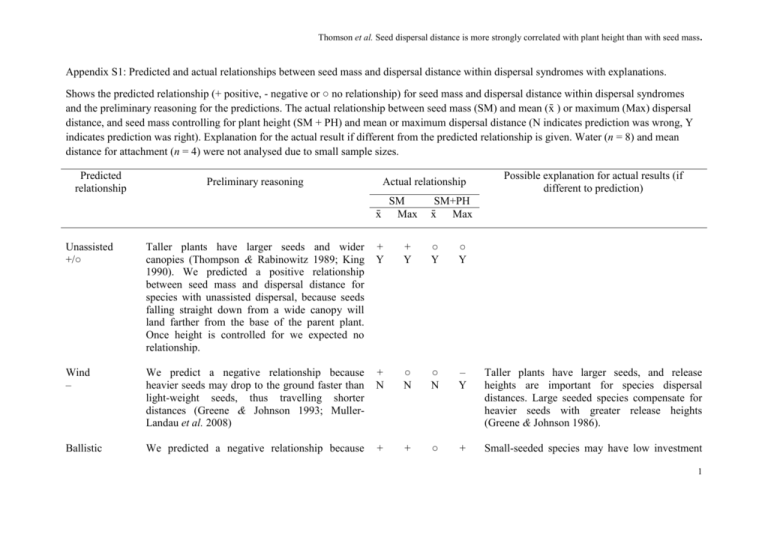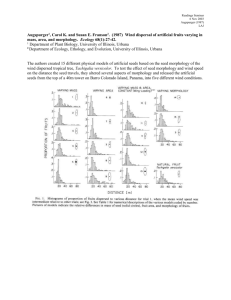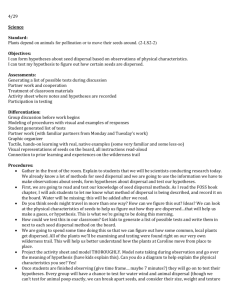JEC_1867_sm_AppS1
advertisement

Thomson et al. Seed dispersal distance is more strongly correlated with plant height than with seed mass. Appendix S1: Predicted and actual relationships between seed mass and dispersal distance within dispersal syndromes with explanations. Shows the predicted relationship (+ positive, - negative or ○ no relationship) for seed mass and dispersal distance within dispersal syndromes and the preliminary reasoning for the predictions. The actual relationship between seed mass (SM) and mean (xˉ ) or maximum (Max) dispersal distance, and seed mass controlling for plant height (SM + PH) and mean or maximum dispersal distance (N indicates prediction was wrong, Y indicates prediction was right). Explanation for the actual result if different from the predicted relationship is given. Water (n = 8) and mean distance for attachment (n = 4) were not analysed due to small sample sizes. Predicted relationship Preliminary reasoning Actual relationship xˉ SM Max Possible explanation for actual results (if different to prediction) SM+PH xˉ Max Unassisted +/○ Taller plants have larger seeds and wider canopies (Thompson & Rabinowitz 1989; King 1990). We predicted a positive relationship between seed mass and dispersal distance for species with unassisted dispersal, because seeds falling straight down from a wide canopy will land farther from the base of the parent plant. Once height is controlled for we expected no relationship. + Y + Y ○ Y ○ Y Wind – We predict a negative relationship because heavier seeds may drop to the ground faster than light-weight seeds, thus travelling shorter distances (Greene & Johnson 1993; MullerLandau et al. 2008) + N ○ N ○ N – Y Taller plants have larger seeds, and release heights are important for species dispersal distances. Large seeded species compensate for heavier seeds with greater release heights (Greene & Johnson 1986). Ballistic We predicted a negative relationship because + + ○ + Small-seeded species may have low investment 1 Thomson et al. Seed dispersal distance is more strongly correlated with plant height than with seed mass. – Narbona, Arista & Ortiz (2005) suggested that large-seeded species may have additional structures on the seed to aid secondary dispersal, and that these dispersal structures may reduce dispersal distance. For two Viola species, the species that invested less in its secondary dispersal syndrome (elaiosome mass) had greater ballistic dispersal distances (Ohkawara & Higashi 1994). N N N N in dispersal because they use secondary dispersal syndromes such as wind or water. Large-seeded species may compensate for weight e.g. by producing high density seeds that increase momentum and seeds being ejected individually with greater accuracy (Stamp & Lucas 1983). Ingestion – We predicted a negative relationship between seed mass and dispersal distance for ingested species, on the basis of observations from previous studies. There was a negative relationship between seed mass and dispersal distance for 31 animal dispersed tropical tree species (Muller-Landau et al. 2008) and for 21 species ingested by mallards (Soons et al. 2008). ○ N ○ N ○ N ○ N The type of vector, vector behaviour and gut passage times may be more important than variation in plant traits for dispersal potential in animals (Will & Tackenberg 2008). Crossspecies differences in reward size, seed number per dispersal unit and protective structures will influence dispersal distance and if seeds are removed. These factors can be independent of seed size. For ruminates there was no relationship between seed mass and dispersal potential (Bruun & Poschlod 2006). Seed-caching + We predicted a positive relationship between seed mass and dispersal distance for species dispersed by seed-caching vertebrates, on the basis of observations from previous studies (Seiwa et al. 2002; Jansen, Bongers & Hemerik 2004; Xiao, Zhang, Wang 2005). The greater potential energy gains from large seeds makes them more attractive than small seeds to seedeaters according to optimal foraging theory ○ N ○ N ○ N ○ N Our results are similar to those of Vander Wall (2003) who also found no relationship between seed mass and dispersal distance. Some vectors may move lots of seeds as opposed to one seed at a time which removes some of the constraints predicted from optimal foraging theory. Differences in seed nutrient content and protective structures between plant species means potential energy gain may not be 2 Thomson et al. Seed dispersal distance is more strongly correlated with plant height than with seed mass. (Orians & Pearson 1979; Stephens & Krebs, 1986). Optimal cache spacing models predict that high value seeds will be taken greater distances than low value seeds (Stapanian & Smith 1978) to stop density- or mass-dependent loss of caches to other foragers. Ant + We predicted a positive relationship because larger ants transport seeds further (Gomez & Espadaler 1998; Ness et al. 2004), and bigger seeds are transported by larger ants (Pfeiffer, Nais & Linsenmair 2006). Also large-seeded species compensate for greater seed mass by increasing elaiosome size (Edwards, Dunlop & Rodgerson 2006) probably making their seeds more or equally attractive to ants as seeds from small-seeded species. Attachment ○ We predicted no relationship because seed mass has little effect on whether seeds attach to vectors (Will, Maussner & Tackenberg 2007) and retention times on fur for smaller seeds may be longer, shorter, or equal compared to large seeds (Kiviniemi & Telenius 1998; Couvreur et al. dependent on seed mass alone (Vander Wall 2003). ○ N ○ N ○ Y ○ N ○ N We suggest that seed mass had little influence on dispersal distance because firstly when small ant species find a large seed that is too heavy to carry, they often remove the elaiosome in situ (Edwards, Dunlop, & Rodgerson 2006), resulting in large seeds being taken very short distances (or not being moved at all). Secondly when resources are scarce, the positive correlation between worker size and load size disappears (Pfeiffer, Nais & Linsenmair 2006), so ants will target both large and small seeds. Lastly ants may select seeds on the nutrient content of the elaiosome not elaiosome/seed size. The nutrient content of elaiosomes may be independent of size, so although the elaiosome is larger the nutrient reward may be smaller making them less attractive to ants. ○ Y 3 Thomson et al. Seed dispersal distance is more strongly correlated with plant height than with seed mass. 2004; Couvreur, Verheyen & Hermy 2005; Römermann, Tackenberg & Poschlod 2005). Furthermore large-seeded species may cancel out the negative impact of seed mass by increasing the number of hooks, spikes or the stickiness of seeds (Kiviniemi & Telenius 1998; Couvreur et al. 2004). Additional References Bruun, H. H. & Poschlod, P. (2006) Why are small seeds dispersed through animal guts: large numbers or seed size per se? Oikos, 113, 402-411. Couvreur, M., Vandenberghe, B., Verheyen, K. & Hermy, M. (2004) An experimental assessment of seed adhesivity on animal furs. Seed Science Research, 14, 147-159. Couvreur, M., Verheyen, K. & Hermy, M. (2005) Experimental assessment of plant seed retention times in fur of cattle and horse. Flora, 200, 136-147. Edwards, W., Dunlop, M. & Rodgerson, L. (2006) The evolution of rewards: seed dispersal, seed size and elaiosome size. Journal of Ecology, 94, 687-694. Jansen, P. A., Bongers, F. & Hemerik, L. (2004) Seed mass and mast seeding enhance dispersal by a neotropical scatter-hoarding rodent. Ecological Monographs, 74, 569-589. Kiviniemi, K. & Telenius, A. (1998) Experiments on adhesive dispersal by wood mouse: seed shadows and dispersal distances of 13 plant species from cultivated areas in southern Sweden. Ecography, 21, 108-116. Narbona, E., Arista, M. & Ortiz, P. L. (2005) Explosive seed dispersal in two perennial mediterranean Euphorbia species (Euphorbiaceae). American Journal of Botany, 92, 510-516. Ohkawara, K. & Higashi, S. (1994) Relative importance of ballistic and ant dispersal in 2 diplochorous viola species (Violaceae). Oecologia, 100, 135-140. Orians, G. H. & Pearson, N. E. (1979) On the theory of central place foraging. Analysis of ecological systems (eds D. J. Horn, R. D. Mitchell & G. R. Stairs), pp. 154-177. Ohio State University Press, Columbus. 4 Thomson et al. Seed dispersal distance is more strongly correlated with plant height than with seed mass. Pfeiffer, M., Nais, J. & Linsenmair, K. E. (2006) Worker size and seed size selection in 'seed'-collecting ant ensembles (Hymenoptera : Formicidae) in primary rain forests on Borneo. Journal of Tropical Ecology, 22, 685-693. Römermann, C., Tackenberg, O. & Poschlod, P. (2005) How to predict attachment potential of seeds to sheep and cattle coat from simple morphological seed traits. Oikos, 110, 219-230. Seiwa, K., Watanabe, A., Irie, K., Kanno, H., Saitoh, T. & Akasaka, S. (2002) Impact of site-induced mouse caching and transport behaviour on regeneration in Castanea crenata. Journal of Vegetation Science, 13, 517-526. Soons, M.B., van der Vlugt, C., van Lith, B., Heil, G.W. & Klaassen, M. (2008) Small seed size increases the potential for dispersal of wetland plants by ducks. Journal of Ecology, 96, 619-627. Stamp, N. E. & Lucas, J. R. (1983) Ecological correlates of explosive seed dispersal. Oecologia, 59, 272-278. Stapanian, M. A. & Smith, C. C. (1978) Model for Seed Scatterhoarding – Coevolution of Fox Squirrels and Black Walnuts. Ecology, 59, 884896. Stephens, D. W. & Krebs, J. R. (1986) Foraging Theory. Princeton University Press, Princeton. Vander Wall, S. B. (2003) Effects of seed size of wind-dispersed pines (Pinus) on secondary seed dispersal and the caching behavior of rodents. Oikos, 100, 25-34. Will, H., Maussner, S. & Tackenberg, O. (2007) Experimental studies of diaspore attachment to animal coats: predicting epizoochorous dispersal potential. Oecologia, 153, 331-339. 5









